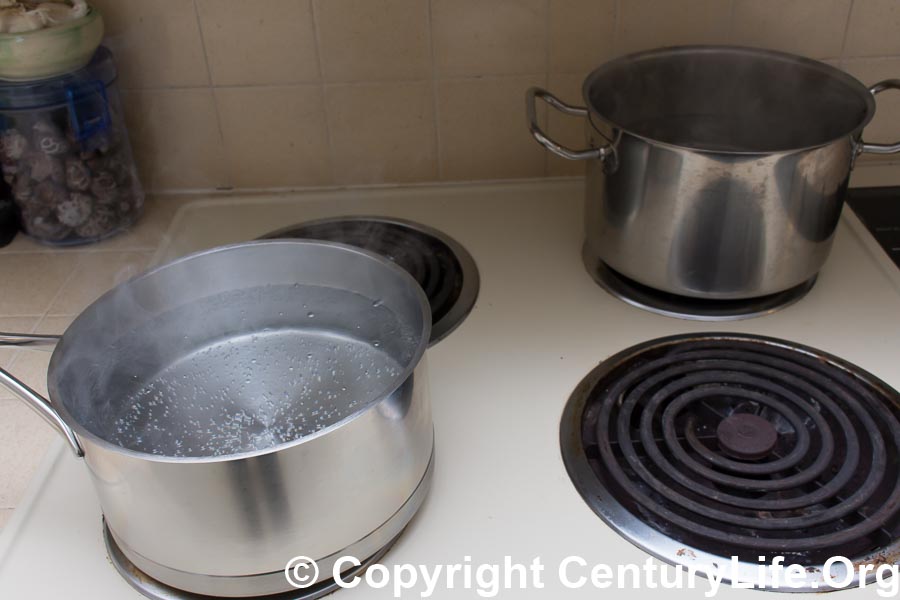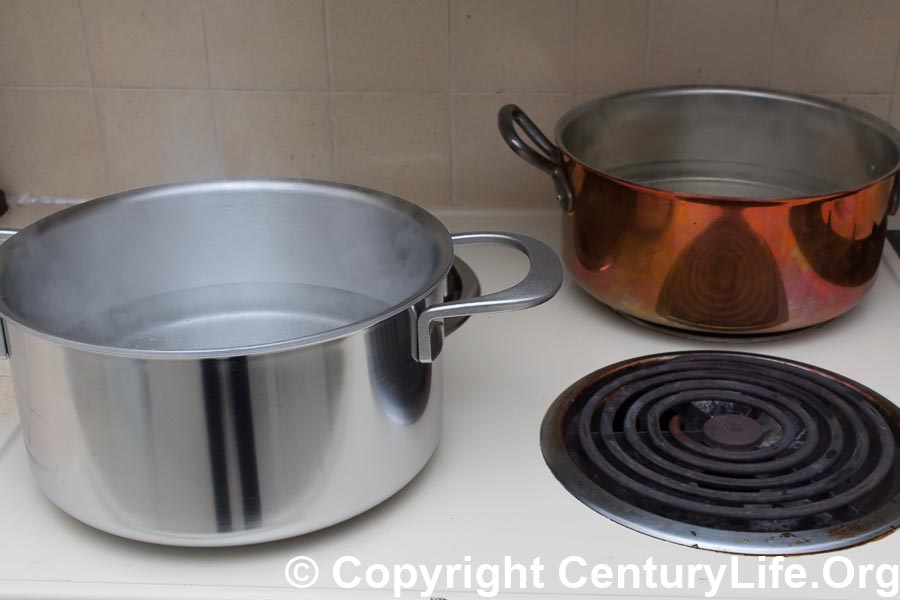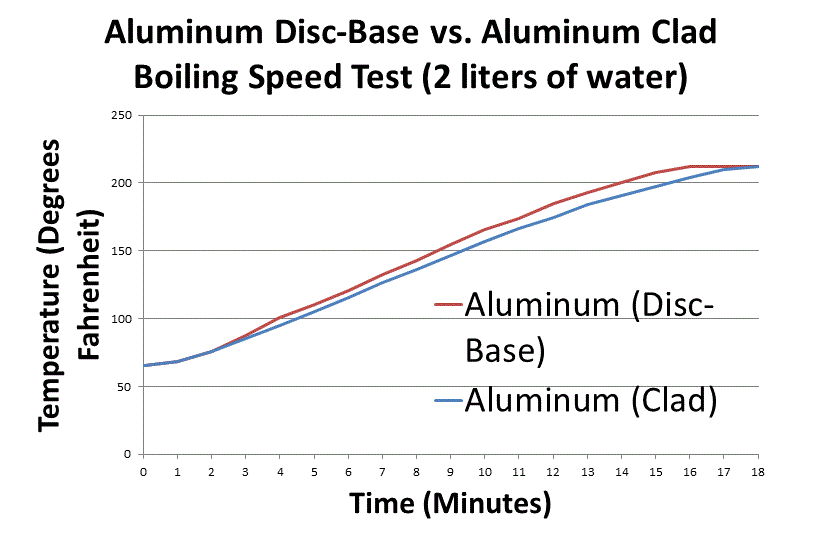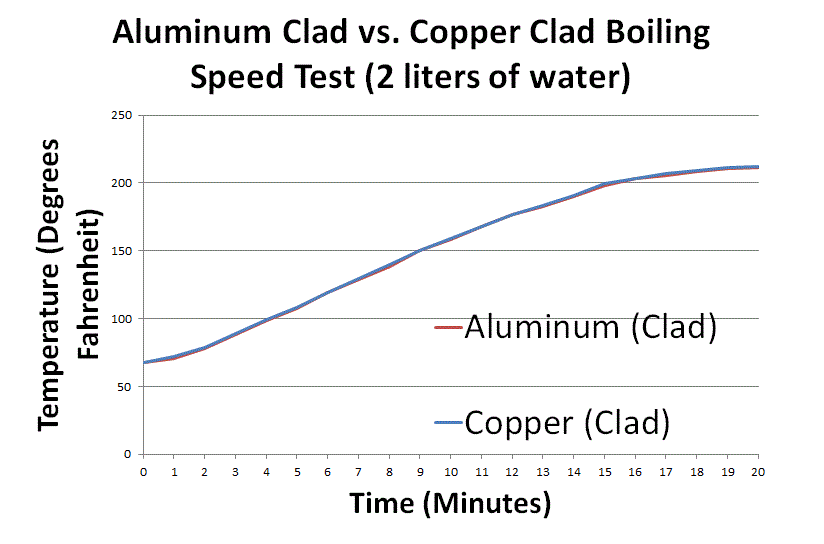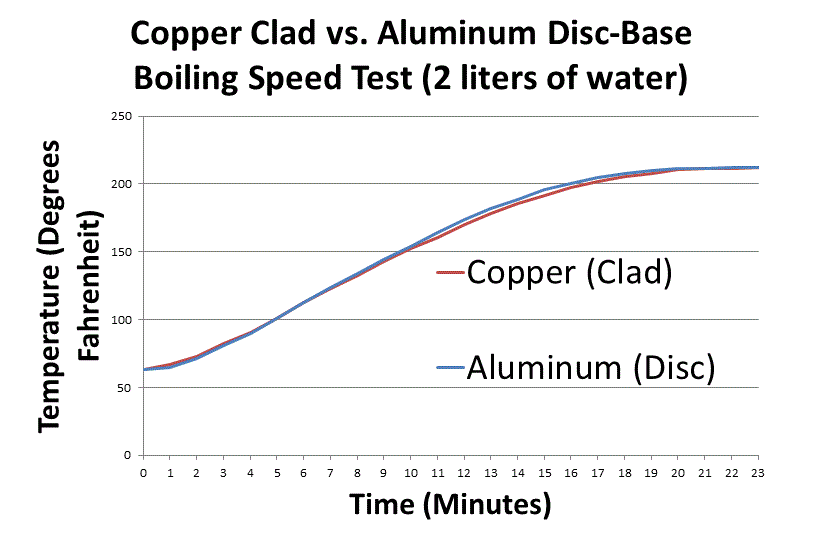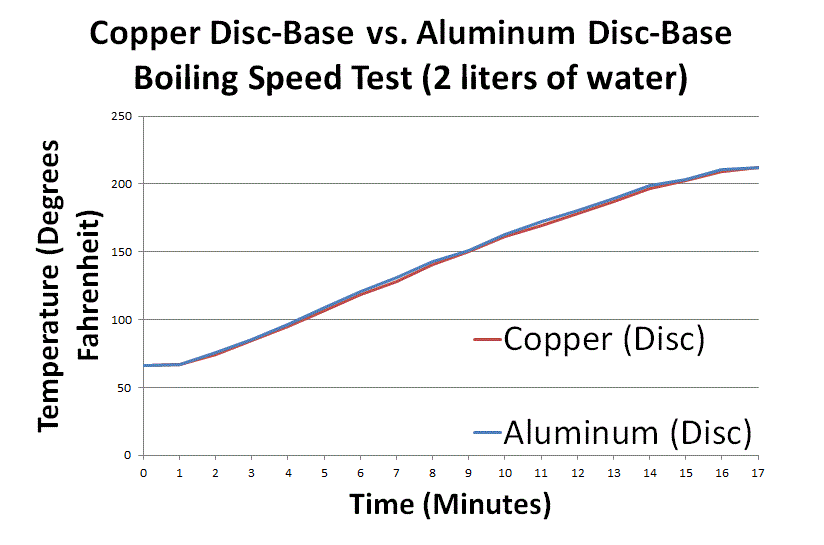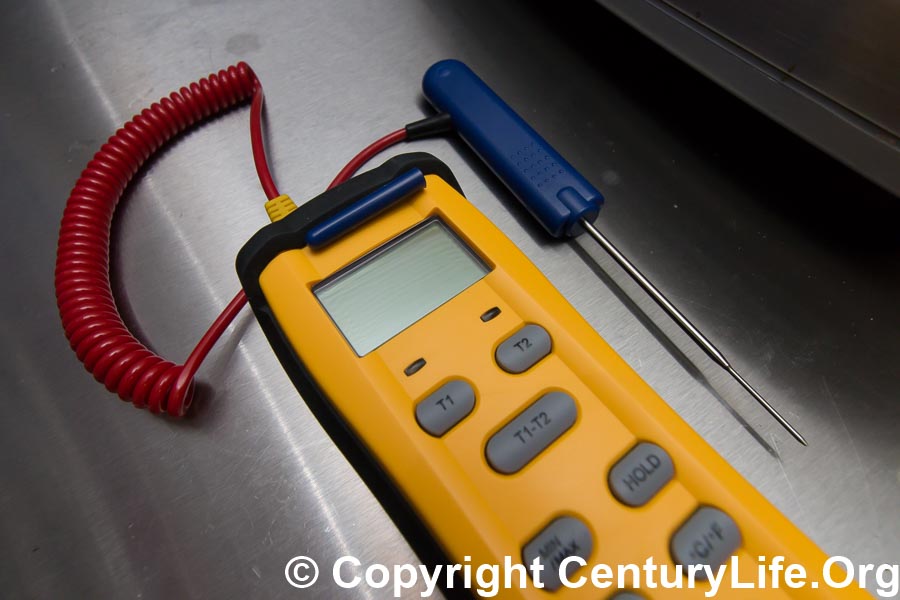
One question I get a lot is “what kind of pot boils water the fastest?” Here’s the answer.
THE PREP
Leaving aside obviously noncompetitive choices like cast iron, the contenders for fastest-boiling pots are:
- Clad (Aluminum) – Stainless-aluminum-stainless. My test subject: a now-discontinued Zwilling Sensation 3-quart saucepan (20cm), the 20cm referring to inner diameter. It’s built like All-Clad Stainless but a bit thicker. Comparing against copper, I used a Zwilling Sensation 5.5-quart casserole (24cm) instead, to match with the copper’s 24cm diameter.
- Clad (Copper) – Solid copper, with a thin lining of stainless steel or tin. My test subject: a Baumalu 5-quart copper casserole (24cm). (In the case of the copper part, I deliberately did not clean it to like-new condition because I don’t think that’s realistic. It’s normal to have clean but not too-clean orange-hued copper.)
- Disc Base (Aluminum) – Aluminum disc base (sometimes covered by stainless steel); stainless steel vessel. My test subject was a Sitram Profiserie Half Stockpot 4-Quart (20cm). Comparing against copper, I used a representative, discontinued department store brand of the same diameter (24cm).
- Disc Base (Copper) – Copper disc base (sometimes covered by stainless steel); stainless steel vessel. My test subject was a Demeyere Atlantis 3.2-quart saucepan (20 cm).
My testing setup consisted of a Tappan electric coil stovetop with four coils, two of which were 6 inches in diameter and two of which were 8 inches in diameter. I used the 6-inchers to guarantee that all pot bottoms were larger in diameter than the coil, with no underhang)1, a pair of Sitram Profiserie 4-Quart Half Stockpots (I review the Sitram Profiserie series here), a Polder 898-95 Clock, Timer and Stopwatch, Black
, a Fieldpiece ST4 Dual Temperature Meter
, and a postal scale. (In other thermal tests, I use a pair of Vollrath Mirage Pro 59500P 1800W portable induction cooker but those are not compatible with copper, so I had to go with coil this time. In the photo above I have the ST4 paired with a Comark PK19M Probe Thermocouple.)
THE TEST METHODOLOGY
I filled a huge mixing bowl with more than 4 liters of water and let it sit overnight to get pretty close to the ambient air temperature. At the same time, I kept all the competitor pots close to each other on a table, to ensure they would be the same temperature. The air temperature in my kitchen was ~68F for all tests.
At the beginning of each test, I filled the competing pots with 2 liters of water, each, from the mixing bowl. This eliminated any possibility that the pots received different-temperature water. I also confirmed the water mass by weight on a postal scale, since volume-based estimates are less reliable. (Technically it wasn’t exactly 2 liters, but 1.996 liters. Water at 4C/39.2F is where 1 gram = 1 milliliter and at room temperature the density of water is slightly less.)
Then I placed the competing pots on the six-inch electric coil burners, made sure to center them as perfectly as I could, and turned up the coils to maximum heat. I measured temperatures dead-center every minute.
I did not cover the pots, because I wanted to know if pot material made any difference in boiling speed. I didn’t want to foul up the results just because some brands make their lids tighter than others. I did do a covered-pot test later, though (see below).
Then I repeated all of the above, but with the pots switched positions, just in case one burner was more powerful than the other. Naturally I had to wait for everything to cool down, first. I simply refilled the mixing bowl, emptied the pots, and waited 24 hours to redo the test. Any variation in humidity should have been pretty minimal.
I averaged the results of the two runs and generated a graph of the results (see below).
Then I did all of the above all over again… once for each competing pair of pots.
I got similar results when repeating the tests on induction stoves and gas burners (I borrowed a friend’s Wolf gas range and already have a pair of Vollrath Mirage Pro 59500Ps which I’ve used on other thermal tests).
THE TEST RESULTS
ANALYSIS
All of these pots boiled water at roughly the same time. The aluminum disc-base vs. aluminum-clad test saw the largest difference, but even there it was just a two-minute boiling speed gap.
Larger amounts of water tended to stretch out the differences–but only modestly. E.g., I placed 3.5 liters of water in the copper clad pot and the aluminum clad pot and used the 8-inch burners. I repeated the test with reversed positions and averaged the results. The copper pot won by 90 seconds, rather than the ~30 seconds when I boiled 2 liters on the smaller burners. Similarly, I boiled 4 liters of water in disc-base copper vs. copper clad on gas burners, and the disc-base pot boiled in 27 minutes compared to 28 minutes for the copper. That 60 second difference was only modestly more than the 30 second gap using 2 liters of water.)
The disc-base designs are most efficient when it comes to boiling water. Heat from the stove goes into the bottom of the pot, heating the water near the bottom of the pot. That hot water rises to the top of the pot of water, and cooler water rushes in to fill the gap, only to get heated as well, continuing the cycle until the entire pot of water is about the same temperature. Not much heat goes directly up the thin, stainless sides since stainless steel is a relatively bad heat conductor. Some small amount of heat gets radiated out the sides into your kitchen.
Non-disc base designs (I lump them all into the “clad” category for purposes of these tests) are like disc-base pots, with a twist: they have sidewalls which conduct heat away from the base regardless of water currents inside the pot. Thus the sidewalls can get hotter than the water and conduct some of that heat into the water and radiate the rest of it outside of the pot, where it goes into your kitchen and gets wasted. The question is whether copper clad beats aluminum clad. The answer: copper clad does beat aluminum-core clad, albeit not by much.
BONUS TEST – HOW MUCH DOES LID MATERIAL MATTER?
I boiled water in the copper pot with the copper lid as well as with a heavy stainless steel lid of the same diameter. Both lids fit about as well.
At 67.2F water and 69.2F air temperature, the copper + copper lid boiled in 16 minutes. The copper + stainless lid boiled in 15 minutes. Not bad when the only difference was switching from copper to stainless lid. This result should come as no surprise. If you’ve ever used a double-walled food or beverage container before, such as a Hydro Flask Insulated Stainless Steel Water Bottle or Thermos Vacuum Insulated Stainless Steel Bottle
, then you know that most of the heat transfer is through the lid, which conducts heat a lot better than the vacuum insulation. Similarly, copper conducts heat a lot better than stainless steel. Thus a copper lid lets more heat escape and means longer boiling times compared to using stainless steel lids.
CONCLUSION
In order of fastest to slowest, the test results were:
1. Copper Disc-base (tie)
2. Aluminum Disc-base (tie)
3. Copper Clad (slightly slower than disc-base)
4. Aluminum Clad (slightly slower than copper)
- To maximize boiling speed, get a disc-base pot with thin stainless steel sidewalls. Since aluminum is cheaper than copper, I would recommend an aluminum disc-base pot such as:
- Fissler Original Pro
(I review it here) – made in Germany, built like a tank with highly corrosion-resistant 18/10 stainless steel, heavy stainless lids with comfortable handles, 6mm-thick aluminum disc base goes all the way to the edges
- Sitram Profiserie (I review it here) – made in France, also built like a tank with 1.2 mm thick 18/10 stainless sidewalls, and also has a ~6mm-thick aluminum disc base, though the disc doesn’t reach the edges like Fissler. Note that Sitram does not include lids, and the official Profiserie lids are terrible anyway, so get third-party lids instead.
- Update International Stock Pot – made in China, reasonably thick stainless sidewalls (0.8mm, which is about as low as you’d want to go for heavy restaurant use, but is perfectly fine for residential use) of 18/8 stainless steel, and a lid is included. As Chinese-made brands go, Update has been around for decades, and their stock pots have comfortable, secure, stay-cool handles. Avoid cheaper Chinese brands, which often use shoddier handles and thinner steel that can dent easily and may be of lower quality. It’s not worth saving five bucks if you drop near-boiling soup into your guest’s lap because the handle breaks suddenly.
- Fissler Original Pro
- However, disc-base designs aren’t perfect:
- Disc-base tends to suffer more than cladded designs when cooking very thick stews/chilis/etc. since convection currents don’t work as well, and very little heat travels up the sidewalls to heat the food sitting in the upper part of the pot. Thus you would need to stir a lot more thoroughly and often.
- Most disc-base designs are also more susceptible to a “ring of fire” (scorched perimeter around the bottom cooking surface) if you are cooking on gas, because most disc-base designs use discs that don’t stretch all the way to the edge of the bottom of the pot.
- Therefore, if you don’t mind giving up a bit of boiling speed, in return for a design that is more versatile, then get a cladded pot such as All-Clad. But if you plan to mostly heat water or other thin liquids, then get a disc-base pot. For those times you cook thicker foods, stir more often.
